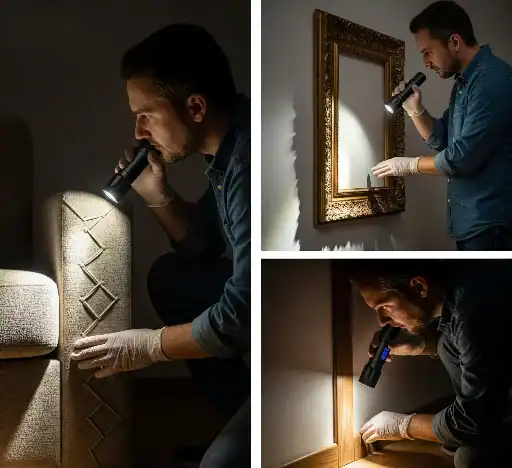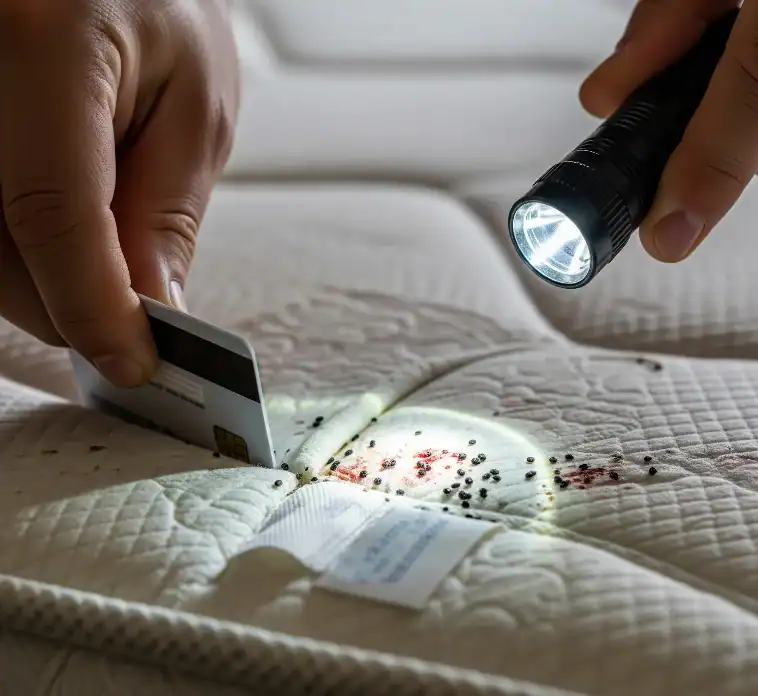When you find them early, you can save yourself time, money, and frustration. It costs far less to treat a small infestation than a widespread issue. This guide shows you exactly how to detect bed bugs before they take over your home.
Many people mistake other insects for bed bugs. This confusion gives real bed bugs more time to spread. Learning proper identification prevents costly mistakes and stops infestations from growing.
Why Early Bed Bug Detection Matters
Bed bugs multiply quickly. Over the course of her life, a single female can lay up to 500 eggs. Within weeks, a few bugs become hundreds. Early detection stops this cycle before it spirals out of control. Professional treatment for minor infestations costs significantly less than whole-house treatments. You also avoid the emotional stress of dealing with a severe bed bug problem.
Signs of Bed Bugs: What to Look For
Bed bug bites alone cannot confirm an infestation. Many people show no reaction to bed bug bites. Other people confuse bed bug bites for bites from mosquitoes, eczema, or an allergy. Physical evidence provides much more reliable proof. Look for these telltale signs when checking for bed bugs:
Blood Stains on Bedding
Blood stains appear when you accidentally crush bed bugs while sleeping. The stains come from the blood the bugs consumed during their meal. Focus your search on areas where your body contacts the bedding the most. Check pillow areas, the middle of the bed, and spots where you typically sleep.
Dark Spots and Bed Bug Excrement
Bed bugs leave dark spots about the size of a period. These spots are bed bug feces containing digested blood. The spots may bleed into fabric like marker ink. Look for these spots on:
-
Mattress seams and corners
-
Box spring fabric
-
Bed frame joints
-
Nearby furniture
-
Wall areas close to your bed
Eggs and Eggshells
The eggs of bed bugs are tiny and white. They are approximately 1 mm in size. They are tiny and pale yellow. They measure about 1mm in size. Look for clusters of eggs in hidden areas where adult bed bugs congregate. You might also find empty eggshells. These indicate recent bed bug activity and successful reproduction in your sleeping area.
Shed Skins from Growing Bed Bugs
Young bed bugs shed their skin as they grow. These cast-off skins look like empty bed bug shells. Finding multiple shed skins suggests an active, growing population.
Sweet, Musty Odors
Fresh bed bug infestations are known to release an odor. The smell is generated by bed bug scent glands and has been described as musty and sweet, like berries, or spicy, like coriander. You typically notice this smell only with severe infestations involving hundreds of bugs.
How to Check for Bed Bugs on Your Mattress
Your mattress requires the most thorough inspection. Bed bugs prefer to stay close to their food source. Follow this systematic approach:
Strip Your Bed Completely
Strip the bed of all bedding, pillows, and mattress protectors. While placing each item in the laundry, look at it carefully. Hot water and high heat drying can also kill bed bugs.
Inspect Mattress Seams and Tags
Run your finger along every mattress seam. Pay special attention to the head of the bed where you rest your head. Bed bugs often cluster in these areas. Check behind the mattress tag and label. These spots provide perfect hiding places for small bed bug populations.
Examine the Box Spring Thoroughly
Box springs offer many hiding spots. Peer beneath the box spring and at the seams. Check dark corners and behind your cushion with a flashlight. The thin fabric covering the box springs tears easily. Bed bugs often hide inside these tears and gaps.
Check Bed Frame and Headboard
Inspect every joint, screw hole, and crack in your bed frame. Bed bugs can fit into spaces as thin as a credit card. If a crack holds a credit card, it could hide a bed bug. Wooden bed frames provide more hiding spots than metal frames. Check behind the headboard where it attaches to the wall.
How to Check for Bed Bugs at Home: Room by Room

Bed bugs spread beyond bedrooms when infestations grow. Just like with other pest control situations, inspect these areas systematically:
Living Room and Furniture
Check upholstered furniture thoroughly. Look in:
-
Couch and chair seams
-
Between cushions
-
Under furniture legs
-
Behind picture frames
-
Along carpet edges
Recliners and sofas where people nap attract bed bugs. These bugs will travel up to 20 feet to find a blood meal.
Other Bedrooms
Inspect all bedrooms in your home. Bed bugs spread through wall voids and electrical outlets. They also hitchhike on clothing and personal items. Guest bedrooms need special attention. When visitors who have been to hotels or other infested sites go to stay, they may unknowingly bring bed bugs with them.
Common Hiding Places Throughout Your Home
Bed bugs hide in surprising locations when populations grow large:
-
Electrical outlets and switch plates
-
Behind loose wallpaper
-
Under carpet edges
-
In curtain folds and drapes
-
Inside alarm clocks and electronics
-
Along the ceiling and wall junctions
-
In drawer joints and furniture cracks
How to Check for Bed Bugs in Hotels
Hotels pose a high risk of bed bug infestations due to their constant guest turnover. Protect yourself with this hotel inspection routine:
Inspect Before Unpacking
Never place luggage on the bed immediately. Use the bathroom or hard surfaces while you inspect the room. Bed bugs cannot easily climb smooth surfaces.
Check the Bed First
Pull back the sheets at the head of the bed. Look along the mattress seam where the pillows rest. This area shows the most bed bug activity in hotel rooms. Check behind the headboard if possible. Many hotel bed bugs hide in this location during daylight hours.
Examine Upholstered Furniture
Hotel chairs and couches can harbor bed bugs. Look in seams and cushion areas. Pay attention to furniture positioned near the bed.
Request a Different Room if Needed
If you find signs of bed bugs, request a room not adjacent to the infested room. Bed bugs travel between rooms through wall voids and electrical systems. Opt for rooms on different floors, when possible. This minimizes your exposure to bed bugs from adjacent infested rooms.
Understanding Bed Bug Behavior and Habits
Knowledge of bed bug behavior improves your detection efforts. These insects follow predictable patterns:
Feeding Patterns
Bed bugs prefer human blood but will feed on pets if necessary. They typically feed every five to seven days when hosts are available. Feeding generally takes place at night. But bed bugs will bite during daylight hours when they detect carbon dioxide and warmth from sleeping humans. A single feeding session lasts three to twelve minutes. Bed bugs inject an anesthetic, so you rarely feel the actual bite.
Daily Activity Cycles
Bed bugs are nocturnal and only venture out at night. They are most active when you are sleeping and helpless. Feeding activity is at its highest intensity just before dawn. This timing coincides with your deepest sleep cycles when you are least likely to disturb feeding bed bugs.
Reproduction and Life Stages
Female bed bugs need blood meals to produce eggs. Well-fed females lay one to three eggs daily. Eggs hatch within six to ten days under ideal conditions. Young bed bugs need blood meals to advance through five growth stages. Each stage requires successful feeding and skin molting. Adult bed bugs can live for a year without feeding. This survival ability makes elimination challenging without professional treatment.
Environmental Preferences
Bedbugs become most active between 70 and 80°F and can survive from close to freezing to 122°F. These vermin like to live inside, in tight spaces where the air doesn’t circulate. Cluttered spaces allow for concealment and are less likely to be disrupted. Bed bugs are killed when exposed to temperatures of 113°F for about an hour. Professional heat treatment uses this weakness to eliminate infestations.
No Signs of Bed Bugs, But I Have Bites: What This Means

Finding bites without other bed bug signs creates confusion. Several explanations exist for this situation:
Other Biting Insects
Many insects produce similar bite patterns. Fleas, mosquitoes, and mites can all cause bite reactions resembling bed bug bites. Spider bites, chigger bites, and even allergic reactions may look like bed bug bites to untrained eyes.
Very Early Infestation
Small bed bug populations produce minimal evidence. You may notice bites before you see physical evidence of bed bugs. Keep watching for other signs such as blood spots, dark spots, and musty smells. Early infestations need to be observed for several weeks.
Hidden Bed Bug Locations
Bed bugs may hide in locations you have not yet inspected. Inspect common areas as well as living rooms, guest rooms, and storage areas. Some bed bugs live in walls, electrical sockets, or furniture you don’t move often. Professional inspection may be necessary to find these hidden populations.
When to Call Professional Help
Some situations require professional bed bug inspection and treatment:
Widespread Infestations
If you find bed bugs in multiple rooms, professional treatment becomes necessary. Whole-house infestations exceed the scope of DIY elimination methods.
Repeated Treatment Failures
Multiple failed attempts to eliminate bed bugs indicate resistance or hidden populations. Exterminators have access to stronger treatments and better detection equipment.
High-Risk Situations
Bed Bug Control for Apartment Communities, Hotels, and Health Care. There are no “do it yourself” methods that will rid you of these bloodsucking nightmares. These locations require coordinated treatment efforts across multiple units.
Prevention After Detection
Finding bed bugs early allows for prevention strategies:
Immediate Containment
Double-bag infected bedding and clothing in plastic bags. Clean in hot water and dry in a dryer on high heat for at least 30 minutes. Vacuum thoroughly around affected areas. Dispose of vacuum contents in sealed bags immediately after use.
Monitoring Techniques
Use bed bug monitors and interceptors around bed legs. These devices trap bed bugs attempting to climb onto your bed. Weekly inspections should continue and persist for at least 6 months after treatment. Bed bugs can emerge from hiding places weeks after initial treatment.
Travel Precautions
Examine hotel rooms carefully before moving in. Store luggage in bathrooms on hard surfaces, not near beds or upholstered furniture. Wash and dry all clothes at high temperature upon returning home. Keep luggage in garages or basements, away from living areas.
FAQs – Bed Bugs
What do bed bugs look like to the human eye?
How fast do bed bugs spread?
What kills bed bugs instantly?
How long can bed bugs live without blood?
How are bedbugs brought into a home?
Are bedbug bites dangerous?
What is the duration required to eradicate bed bugs?
Can I treat bed bugs myself?
Conclusion
The sooner you detect bedbugs, the better, as they reproduce quickly, making them harder to eliminate and more expensive to exterminate. Go with physical evidence, not just bites. Search mattresses, furniture, and hiding places systematically. Remember that bed bugs are good at hiding. In areas with few people, they can linger undetected for weeks. Continue to monitor even if initial searches fail to yield any evidence.
If bugs begin to appear in more rooms, or if DIY measures don’t obviously reduce the number of insects, a professional should be called. It costs less in the long run to control outbreaks early than to control a major infestation. Be careful when travelling and with overnight visitors. Spread by human activity, bedbugs are also fantastic hitchhikers and, when in cloth, luggage, and the like, can get a free ride. Knowing how they operate and where to look for them is how you keep these unwanted houseguests from getting in.
















